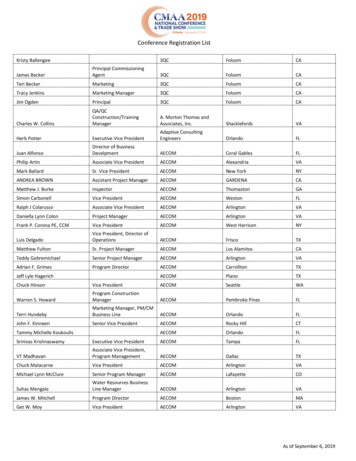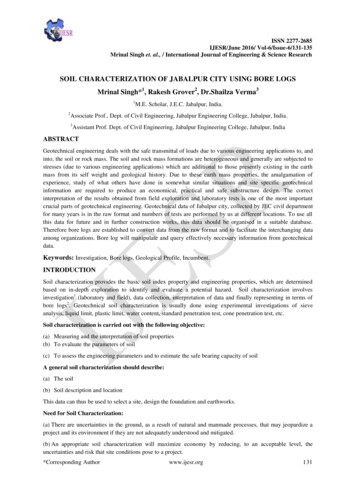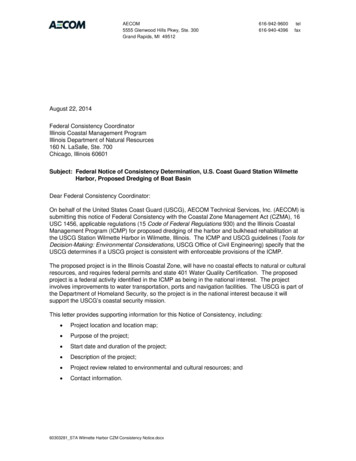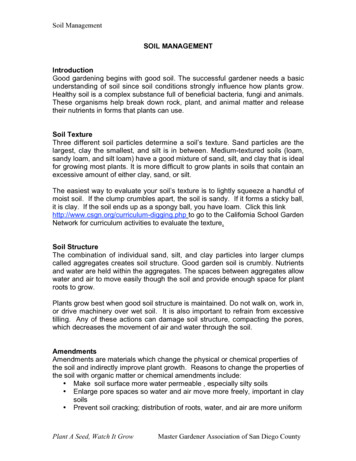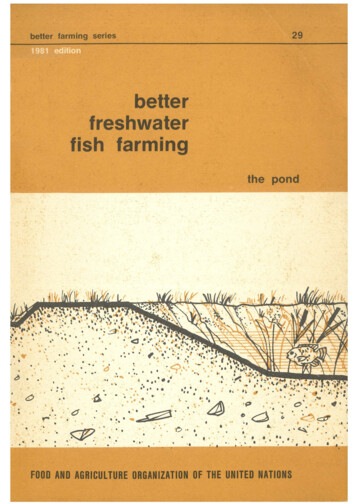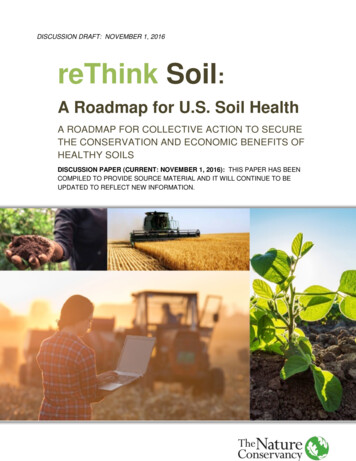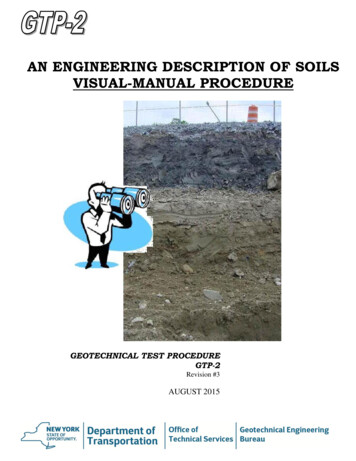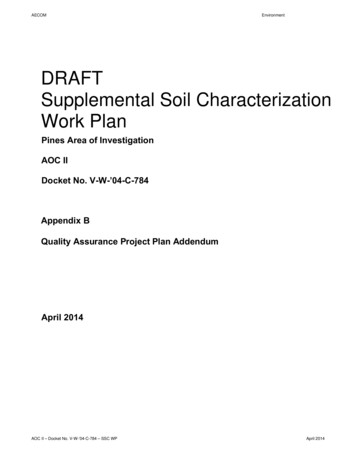
Transcription
AECOMEnvironmentDRAFTSupplemental Soil CharacterizationWork PlanPines Area of InvestigationAOC IIDocket No. V-W-’04-C-784Appendix BQuality Assurance Project Plan AddendumApril 2014AOC II – Docket No. V-W-’04-C-784 – SSC WPApril 2014
Quality Assurance Project Plan AddendumRemedial Investigation/Feasibility StudyPines Area of InvestigationSection:Revision:Date:Cover Page1April 2014Supplemental Soil CharacterizationQuality Assurance Project Plan AddendumPines Area of InvestigationAOC IIDocket No. V-W-’04-C-784AECOMApril 2014AOC II – Docket No. V-W-’04-C-784 – SSC WPApril 2014
AECOMEnvironmentQuality Assurance Project Plan AddendumRemedial Investigation/Feasibility StudyPines Area of pril 20141 of 1QUALITY ASSURANCE PROJECT PLAN ADDENDUMSUPPLEMENTAL SOIL CHARACTERIZATIONPINES AREA OF INVESTIGATIONRevision 1Prepared by: AECOMPrepared for: Brown Inc. and NIPSCOApril 14, 2014DateAECOM Project ManagerLisa JN BradleyApril 14, 2014AECOM Project Quality Assurance OfficerDebra SimmonsDateUSEPA Region V Remedial Project ManagerErik HardinDateUSEPA Region V QA Plan ReviewerDateAOC II – Docket No. V-W-’04-C-784 – SSC WPApril 2014
AECOMEnvironmentQuality Assurance Project Plan AddendumRemedial Investigation/Feasibility StudyPines Area of on List1April 20141 of 1DISTRIBUTION LISTErik Hardin, USEPALisa JN Bradley, AECOMValerie Blumenfeld, Brown Inc.Dan Sullivan, NiSourceRobert Shoemaker, AECOMDebra L. Simmons, AECOMJanice Jaeger, ALSEdith Kent, General Engineering LaboratoriesKeith Wagner, RJ Lee GroupAOC II – Docket No. V-W-’04-C-784 – SSC WPApril 2014
AECOMEnvironmentQuality Assurance Project Plan AddendumRemedial Investigation/Feasibility StudyPines Area of pril 2014i of ivContentsQAPP APPROVAL SHEETDISTRIBUTION LISTTABLE OF CONTENTSACRONYMSSTANDARD CHEMICAL ABBREVIATIONSDISCLAIMERA.0PROJECT MANAGEMENT . 1A.1 Introduction . 1A.2 Project Schedule . 1A.3 Distribution List . 1A.4 Project/Task Organization. 1A.5 Problem Definition and Background . 1A.6 Project/Task Description . 1A.7 Quality Objectives and Criteria for Measurement Data . 2B.0MEASUREMENT/DATA ACQUISITION . 1B.1 Sampling Process Design . 1B.2 Sampling Methods Requirements . 1B.2.1Field Measurements . 1B.2.2Sampling Procedures . 1B.3 Sample Handling and Custody . 1B.3.1Sample Containers, Preservation, and Holding Times . 1B.3.2Sample Labeling . 1B.4 Analytical Methods . 1B.4.1Laboratory Analytical Procedures . 2B.4.1.1 Metals. 2B.4.1.2 Particulate Matter . 2B.4.1.3 Radionuclides. 3B.4.2List of Project Target Constituents and Detection Limits. 3B.5 Quality Control . 3AOC II – Docket No. V-W-’04-C-784 – SSC WPApril 2014
AECOMEnvironmentQuality Assurance Project Plan AddendumRemedial Investigation/Feasibility StudyPines Area of pril 2014ii of ivB.6 Instrument/Equipment Testing, Inspection, and Maintenance. 4B.6.1Field Instrument Maintenance . 4B.7 Laboratory Instrument Preventative Maintenance . 4B.8 Instrument/Equipment Calibration and Frequency . 4B.8.1Field Instruments . 4B.8.2Analytical Instrumentation . 4C.0PROJECT ASSESSMENT/OVERSIGHT . 1D.0DATA VALIDATION AND USABILITY . 1REFERENCES . 1ATTACHMENT ALABORATORY STANDARD OPERATING PROCEDURESATTACHMENT BGamma Spectroscopy LibraryATTACHMENT CRadioisotope Calculation SpreadsheetAOC II – Docket No. V-W-’04-C-784 – SSC WPApril 2014
AECOMEnvironmentQuality Assurance Project Plan AddendumRemedial Investigation/Feasibility StudyPines Area of pril 2014iii of ivList of TablesTable A-1Sample SummaryTable A-2Laboratory Parameters by Sample MediumTable A-3Target Analytes, Reporting Limits, and Data Quality Levels for MetalsTable A-4Target Analytes, Reporting Limits, and Data Quality Levels for RadionuclidesTable A-5Quality Control Performance Criteria for Soil SamplesTable B-1Summary of Sample Container, Preservation, and Holding Time Requirements for Soiland CCB/Soil Mixture SamplesTable B-2Analytical MethodologiesTable B-3Analytical Quality Control ChecksTable B-4Maintenance Procedures and Schedule for Field InstrumentsTable B-5Maintenance Procedures and Schedule for Analytical InstrumentsTable B-6Laboratory Equipment MonitoringTable B-7Field Instrument CalibrationTable B-8Analytical Instrument CalibrationAOC II – Docket No. V-W-’04-C-784 – SSC WPApril 2014
AECOMEnvironmentQuality Assurance Project Plan AddendumRemedial Investigation/Feasibility StudyPines Area of pril 2014iv of ivList of FiguresFigure A-1Project Organization ChartAOC II – Docket No. V-W-’04-C-784 – SSC WPApril 2014
AECOMEnvironmentQuality Assurance Project Plan AddendumRemedial Investigation/Feasibility StudyPines Area of pril 20141 of 3AcronymsALSThe ALS GroupAOC IIAdministrative Order on Consent, 2004; Docket No. V-W-’04-C-784bgsbelow ground surface Cdegrees CelsiusCASChemical Abstracts ServiceCCBCoal Combustion By-productCCBKContinuing Calibration BlankDOEDepartment of EnergyDQLData Quality LevelEMElectron MultiplierEMLEnvironmental Measurements LaboratoryFSFeasibility StudyFWHMFull Width at Half MaximumGELGeneral Engineering LaboratoryHASLHealth and Safety LaboratoryICInductively CoupledICBKInitial Calibration BlankICP-AESInductively Coupled Plasma-Atomic Emission SpectroscopyICP-MSInductively Coupled Plasma-Mass SpectrometryIDLInstrument Detection LimitkeVkiloelectron voltLCSLaboratory Control SampleLOILoss on IgnitionMDCMinimum Detectable ConcentrationMDLMethod Detection Limitmg/kgmilligram per kilogrammLmilliliterMRLMethod Reporting LimitMS/MSDMatrix Spike/Matrix Spike DuplicateNANot ApplicableAOC II – Docket No. V-W-’04-C-784 – SSC WPApril 2014
AECOMEnvironmentQuality Assurance Project Plan AddendumRemedial Investigation/Feasibility StudyPines Area of InvestigationNIPSCONorthern Indiana Public Service CompanyNISTNational Institute of Standards and TechnologyNORMNaturally Occurring Radioactive MaterialORPOxidation-Reduction PotentialozouncepCi/gPicocuries per gramPLMpolarized light microscopyPRGPreliminary Remediation GoalQAQuality AssuranceQAPPQuality Assurance Project PlanQCQuality Control%RPercent RecoveryRIRemedial InvestigationRI/FSRemedial Investigation and Feasibility StudyRJ LeeRJ Lee GroupRLReporting LimitRPDRelative Percent DifferenceRSDRelative Standard DeviationRSLRegional Screening LevelSOPStandard Operating ProcedureSOWStatement of WorkSRSample ResultSSCSupplemental Soil CharacterizationTOCTotal Organic Carbonug/Lmicrograms per literUSEPAUnited States Environmental Protection AgencyXRDX-Ray DiffractionXRFX-Ray FluorescenceAOC II – Docket No. V-W-’04-C-784 – SSC WPSection:Revision:Date:Page:Acronyms1April 20142 of 3April 2014
AECOMEnvironmentQuality Assurance Project Plan AddendumRemedial Investigation/Feasibility StudyPines Area of pril 20143 of 3Standard Chemical mThThoriumTlThalliumUUraniumVVanadiumAOC II – Docket No. V-W-’04-C-784 – SSC WPApril 2014
AECOMQuality Assurance Project Plan AddendumRemedial Investigation/Feasibility StudyPines Area of :Disclaimer1April 20141 of 1DisclaimerThis document is a draft document prepared under a federal administrative order on consent. Thisdocument has not undergone formal review by U.S. Environmental Protection Agency (USEPA),however, this document has incorporated comments provided by USEPA on the previous draftversion of the report (see Appendix D of this Supplemental Soil Characterization (SSC) Work Plan).The opinions, findings, and conclusions expressed are those of the author and not necessarily thoseof USEPA.AOC II – Docket No. V-W-’04-C-784 – SSC WPApril 2014
AECOMEnvironmentQuality Assurance Project Plan AddendumRemedial Investigation/Feasibility StudyPines Area of InvestigationSection:Revision:Date:Page:Section A1April 20141 of 2A.0 Project ManagementA.1IntroductionIn April 2004, the United States Environmental Protection Agency (USEPA) and the Respondents(Brown Inc., Ddalt Corp., Bulk Transport Corp., and Northern Indiana Public Service Company(NIPSCO)) signed an Administrative Order on Consent (AOC II) (Docket No. V-W-’04-C-784) toconduct a Remedial Investigation and Feasibility Study (RI/FS) at the Pines Area of Investigation,located in the environs of the Town of Pines, Indiana, as set forth in Exhibit I to II (AOC II, 2004).AOC II (Section VII. 22) and its attachment, the Statement of Work (SOW) (Task 8), require theRespondents to conduct a Feasibility Study (FS) as part of the RI/FS process. As documented in theFS (AECOM, 2014a), additional soil investigations will be conducted. A Supplemental SoilCharacterization (SSC) Work Plan (AECOM, 2014b) provides the details for conducting this work.This Quality Assurance Project Plan (QAPP) Addendum incorporates the RI/FS QAPP (AECOM,2005) by reference and was prepared to reflect the scope of work described in the SSC Work Plan,and is provided as Appendix B of the Work Plan.A.2Project ScheduleThe project schedule is presented in Section 6.0 of the Supplemental Soil Characterization Work Plan.A.3Distribution ListThe QAPP Addendum, and any subsequent revisions, will be distributed to the personnel shown onthe Distribution List that immediately follows the approval page.A.4Project/Task OrganizationThe lines of authority and communication specific to the Quality Assurance (QA) program for thisadditional soil investigation are presented in Figure A-1.A.5Problem Definition and BackgroundBackground and the objectives specific to the additional soil investigation are provided in Sections 1.1and 1.2, respectively, of the SSC Work Plan.A.6Project/Task DescriptionTo meet the objectives defined in the SSC Work Plan, three data collection tasks will be conducted:1. Gamma count rate and gamma dose rate surveys2. Coal combustion by-product (CCB) visual inspection confirmation sampling3. Soil sampling of selected properties for specific constituentsThe number of field and quality control (QC) samples that will be collected for each analyticalparameter is presented in Table A-1. A summary of analytical parameters by medium is presented inAOC II – Docket No. V-W-’04-C-784 – SSC WPApril 2014
AECOMEnvironmentQuality Assurance Project Plan AddendumRemedial Investigation/Feasibility StudyPines Area of InvestigationSection:Revision:Date:Page:Section A1April 20142 of 2Table A-2. Target compounds and analytical parameters for all matrices are presented with theirrespective laboratory detection limits and data quality levels (DQLs) in Tables A-3 (Metals) and TableA-4 (Radionuclides).All data generated from field activities or from the analytical program will be reviewed internallythrough a tiered review process and validated prior to reporting. All of the data will be validated aslimited validation (refer to the RI/FS QAPP [AECOM, 2005] for a detailed description of validationprocedures).A.7Quality Objectives and Criteria for Measurement DataThe objectives for precision, accuracy, and sensitivity are provided in Table A-5.AOC II – Docket No. V-W-’04-C-784 – SSC WPApril 2014
AECOMEnvironmentQuality Assurance Project Plan AddendumRemedial Investigation/Feasibility StudyPines Area of InvestigationSection:Revision:Date:Page:Section B1April 20141 of 3B.0 Measurement/Data AcquisitionB.1Sampling Process DesignThe rationale for the sample design is provided in Section 3.0 of the SSC Work Plan.B.2Sampling Methods RequirementsB.2.1 Field MeasurementsField measurements will include a gamma walk-over survey and a gamma dose rate survey. Theseprocedures are described in Sections 3.2.1 and 3.2.2 of the SSC Work Plan. Standard operatingprocedures (SOPs) are included in Appendix C of the SSC Work Plan.B.2.2 Sampling ProceduresThe SOPs that will be utilized for CCB visual inspection confirmation sampling and private propertysoil sampling (Sections 3.3 and 3.4 of the SSC Work Plan, respectively) are provided in Appendix C ofthe SSC Work Plan.B.3Sample Handling and CustodyB.3.1 Sample Containers, Preservation, and Holding TimesA summary of sample container, preservation, and holding time requirements is presented in TableB-1.B.3.2 Sample LabelingLabeling of sample containers is described in Section 4.2.2.2 of the SSC Work Plan.B.4Analytical MethodsAnalyses will be performed by laboratories that have been utilized for previous investigations at thePines Area of Investigation and approved by USEPA. Chemical analyses of soil samples for metals(including hexavalent chromium), except total uranium will be performed by The ALS Group (ALS;formerly Columbia Analytical Services, Inc.) in Rochester, NY. Gamma spectroscopy analyses for theradioisotopes and inductively coupled plasma – mass spectroscopy (ICP-MS) for total uranium(calculated from U-235 and U-238) will be performed by General Engineering Laboratories, LLC(GEL) in Charleston, SC. Particulate matter analyses will be performed by RJ Lee Group (RJ Lee) inMonroeville, PA.AOC II – Docket No. V-W-’04-C-784 – SSC WPApril 2014
AECOMEnvironmentQuality Assurance Project Plan AddendumRemedial Investigation/Feasibility StudyPines Area of InvestigationSection:Revision:Date:Page:Section B1April 20142 of 3B.4.1 Laboratory Analytical ProceduresB.4.1.1 MetalsA list of the ALS and GEL SOPs for metals analyses is provided in Table B-2. The SOPs are includedin Attachment A.B.4.1.2 Particulate MatterThe particulate matter analysis by RJ Lee will consist of polarized light microscopy (PLM), X-raydiffraction (XRD), X-ray fluorescence (XRF), and loss on ignition (LOI). The PLM analysis will be usedto identify crystalline and non-crystalline glassy and organic phases in the sample and to identifyparticles with fly ash or bottom ash morphologies. The PLM analyses will be performed in generalaccordance to EPA 600/R‐93/116, Test Method for the Determination of Asbestos in Bulk BuildingMaterials. The SOPs for the particulate matter analysis are not included in Attachment A because RJLee considers them to be proprietary. The SOPs are available for review at the RJ Lee facility. Asummary of the procedures are presented below.The sample will be spread on a grid on one or more glass slides, and 400 random points on that gridare observed. Particles will be identified by the microscopist as either fly ash or bottom ash and theseparticles will be counted. If one particle of fly ash is counted in any of those 400 grid squares, thesample will be reported as containing 0.25% fly ash. If a single fly ash article is observed in the lightmicroscopy field, but it is not contained in any of the 400 grid squares randomly selected for counting,a result of “trace” will be reported, which quantitatively is 0.25% fly ash. The same method will applyto the bottom ash results.Particle Counting Interpretations Observations on a 400-point GridResultObservations on a 400-point GridNDNo particles observed within or outside of the grid 0.25%No particles observed within the grid, but particle(s) observed upon review of theentire slide0.25%1 particle observed within the grid0.5%2 particles observed0.75%31%41.5%62%8The XRD analysis will be used to identify the crystalline phases present in the samples and will beperformed in general accordance to ASTM D934, Standard Practices for Identification of CrystallineCompounds in Water-Formed Deposits by X-ray Diffraction. The LOI analysis (based on ASTMD7348, Standard Test Methods for Loss on Ignition (LOI) of Solid Combustion Residues) will be usedto determine the weight of percent organic and volatile constituents in the sample and to prepare theAOC II – Docket No. V-W-’04-C-784 – SSC WPApril 2014
AECOMEnvironmentQuality Assurance Project Plan AddendumRemedial Investigation/Feasibility StudyPines Area of InvestigationSection:Revision:Date:Page:Section B1April 20143 of 3samples for XRF analysis by removing the carbonaceous material, carbon dioxide, and water content.The XRF analysis will be used to determine the elemental composition of the residual material in thesample. XRF will be performed in general accordance to ASTM D4326, Standard Method for Analysisof Coal and Coal Ash by X-ray Fluorescence.B.4.1.3 RadionuclidesA list of the GEL SOPs is provided in Table B-2. The SOPs are included in Attachment A.For the radionuclides by gamma spectroscopy, GEL will dry and prep samples according to theirSOPs and seal samples in a 100 cc “tuna can” sample container for a minimum of 28-days prior toanalyses. The samples will be counted using the more sensitive detector (N-type) and will be countedfor a sufficient amount of time, to a maximum count time of 1000 minutes, in order to meet theminimum detectable concentration (MDC) requirements in Table A-4. The radionuclides that will bereported for the soil samples will be based on the gamma spectroscopy library that is provided inAttachment B.The following limits on sensitivity parameters will be applied for gamma spectroscopy analysis: Energy Tolerance: 1.5 kiloelectron volts (keV)Peak Sensitivity: 3.0Abundance Limit: 75%GEL will conduct a thorough review of 'Unidentified Peaks' and note such peaks with comments in thebatch narrative. Any nuclides identified in the 'Unidentified Peaks' report that are not already beingreported may be added to the library following approval by the AECOM project manager. For eachradionuclide in the gamma library, GEL will report the concentration along with its sample specificuncertainty for each sample as obtained during analysis even if the concentration is less than theMDC or is negative (Section 16.6 in MARLAP, 2004).USEPA plans to collect split samples for independent analysis. The specific procedures for sampleselection, collection, and shipment will be provided by USEPA and will be accommodated in the field.B.4.2 List of Project Target Constituents and Detection LimitsA listing of project target constituents and reporting limits (RLs) or MDCs for each analyte group listedin Table B-2 can be found in Tables A-3 (metals) and A-4 (radionuclides).B.5Quality ControlTable B-3 summarizes the QC for the analytical methods. Field QC will include field duplicates,equipment blanks, and matrix spike/matrix spike duplicate (MS/MSD) samples, as appropriate for theanalytical method. Table A-5 presents the limits for each field QC sample. Procedures andfrequencies will be consistent with those described in the RI/FS QAPP.AOC II – Docket No. V-W-’04-C-784 – SSC WPApril 2014
AECOMEnvironmentQuality Assurance Project Plan AddendumRemedial Investigation/Feasibility StudyPines Area of InvestigationB.6Section:Revision:Date:Page:Section B1April 20144 of 3Instrument/Equipment Testing, Inspection, and MaintenanceB.6.1 Field Instrument MaintenanceThe maintenance schedule and trouble-shooting procedures for field instrument are indicated inTable B-4.B.7Laboratory Instrument Preventative MaintenanceTable B-5 provides the frequency with which components of key analytical instruments will beserviced. Table B-6 provides a summary of the monitoring of laboratory equipment.B.8Instrument/Equipment Calibration and FrequencyB.8.1 Field InstrumentsCalibration of field instruments will be performed according to the manufacturer’s instructions and theSOPs included in Appendix C of the SSC Work Plan. A summary of calibration procedures andfrequencies is provided as Table B-7.B.8.2 Analytical InstrumentationThe SOP for each analysis performed in the laboratory describes the calibration procedures, theirfrequency, acceptance criteria, and the conditions that will require recalibration. This information issummarized in Table B-8. The SOPs are included as Attachment A.AOC II – Docket No. V-W-’04-C-784 – SSC WPApril 2014
AECOMQuality Assurance Project Plan AddendumRemedial Investigation/Feasibility StudyPines Area of :Section C1April 20141 of 1C.0 Project Assessment/OversightNo audits of field activities or the laboratory analyses associated with the investigation to beconducted under the SSC Work Plan are planned.AOC II – Docket No. V-W-’04-C-784 – SSC WPApril 2014
AECOMQuality Assurance Project Plan AddendumRemedial Investigation/Feasibility StudyPines Area of :Section D1April 20141 of 1D.0 Data Validation and UsabilityAll chemical and radiochemical data will be subjected to limited validation. The elements of limitedvalidated are described in the RI/FS QAPP (AECOM, 2005).AOC II – Docket No. V-W-’04-C-784 – SSC WPApril 2014
AECOMQuality Assurance Project Plan AddendumRemedial Investigation/Feasibility StudyPines Area of :References1April 20141 of 1ReferencesAECOM. 2005. Remedial Investigation/Feasibility Study Work Plan, Volumes 1-7. September 16,2005.AECOM. 2014a. Feasibility Study. Pines Area of Investigation. February 2014.AECOM. 2014b. Supplemental Soil Characterization Work Plan. Pines Area of Investigation. April2014.MARLAP. 2004. Multi-Agency Radiological Laboratory Analytical Protocols Manual. July 2004.AOC II – Docket No. V-W-’04-C-784 – SSC WPApril 2014
AECOMEnvironmentSection:Revision:Date:Page:Quality Assurance Project Plan AddendumRemedial Investigation/Feasibility StudyPines Area of InvestigationTables1April 20141 of 18Table A-1 Sample SummaryMatrixSoil Soil/CCBMixtureNumber ofLocations(Samples)9 properties4 quadrants per4property (up to 7quadrants ifspecial uses)1 composite (from5 locations) perquadrant3 depths5:0 - 6 inches belowground surface(bgs),6 -18 inches bgs,and1.5 - 5 feet bgs.Total samples 72 lt, iron,thallium, totaluranium,vanadium, tes8-19MS/3MSDs8-19pairsNoneParticulatematter (PLM,XRF, XRD, LOI)NA0NA1Equipment rinsate blanks will be collected when non-disposable or non-dedicated equipment is used.Collected at a frequency of one per 10 samples submitted for analysis.3Collected at a frequency of one per 10 samples submitted for analysis, except not applicable to radionuclides.4Up to 7 quadrants may be established based on the property size and to address three specific property uses, asdefined in Section 1.3.4 of the SSC Work Plan.5Samples collected at the 1.5 - 5 foot horizon will be submitted for analysis only if CCBs are visually observed in at least 1of the 5 samples to be composited from a single quadrant.6Refer to Table A-4 for the specific list of radionuclides.2bgs – below ground surfaceCCB – Coal Combustion By-productLOI – Loss on IgnitionNA – Not ApplicableMS/MSD – Matrix Spike/Matrix Spike DuplicatePLM – Polarized Light MicroscopySSC – Supplemental Soil CharacterizationXRF – X-ray FluorescenceXRD –X-ray DiffractionAOC II – Docket No. V-W-’04-C-784 – SSC WPApril 2014
AECOMEnvironmentQuality Assurance Project Plan AddendumRemedial Investigation/Feasibility StudyPines Area of il 20142 of 18Table A-2 Laboratory Parameters by Sample MediumParameterMetals1Hexavalent chromiumPercent moistureRadionuclides2Particulate matter3Soil4XXXXSoil/CCB Mixtures4X1Refer to Table A-3 for the specific list of analytes.2Refer to Table A-4 for the specific list of radionuclides.3PLM, XRF, XRD, LOI4Note that particulate matter analyses will be conducted on samples collected from locationswhere CCBs were previously identified to be present. CCBs may also be present in the soilsamples identified for collection in Table A-1, however, those samples will be collected withoutbiasing the sample locations based on the presence or absence of CCBs.CCB – Coal Combustion By-productLOI – Loss on IgnitionPLM – Polarized Light MicroscopyXRD – X-Ray DiffractionXRF – X-Ray FluorescenceAOC II – Docket No. V-W-’04-C-784 – SSC WPApril 2014
AECOMEnvironmentQuality Assurance Project Plan AddendumRemedial Investigation/Feasibility StudyPines Area of il 20143 of 18Table A-3 Target Analytes, Reporting Limits, and Data Quality Levels for MetalsAnalytesCAS NumberMetals by -6Metals by ICP-MSArsenic7440-38-2Chromium (total)7440-47-3Thallium7440-28-0Uranium (total)7440-61-1U-235see total uraniumU-238see total uraniumVanadium7440-62-2Hexavalent Chromium18540-29-9Chromium(hexavalent)123MDL1 .004380.200.002390.10see below0.0020.0140.01320.0400.01640.200.0570.40DQL – USEPA November 2013Residential 3ncsee total uraniumsee total uranium39nc0.29cLaboratory RLs, MDLs (GEL), and IDLs (ALS) are updated periodically and are dependent on aliquot weight andpercent moisture of the samples. MDLs and IDLs are updated periodically; the current MDLs and IDLs at the time ofanalyses will be used.Nondetects for ICP-AES and ICP-MS analyses will be reported at the MDLs or IDLs to ensure achievement of theDQL.Regional Screening Levels for Chemical Contaminants at Superfund Sites. November ex.html. Values for residential soil. If RSL is based on a noncancerendpoint (nc), the RSL is adjusted to a hazard quotient of 0.1 by multiplying the RSL by 0.1. The risk level is 1E-6 ifthe RSL is based on a cancer endpoint (c).CAS – Chemical Abstracts ServiceDQL – Data Quality LevelICP-AES – Inductively Coupled Plasma-Atomic Emission SpectroscopyICP-MS – Inductively Coupled Plasma-Mass SpectrometryIDL – Instrument Detection LimitMDL – Method Detection Limitmg/kg – milligrams per kilogramRSL – Regional Screening LevelRL – Reporting LimitUSEPA – United States Environmental Protection AgencyAOC II – Docket No. V-W-’04-C-784 – SSC WPApril 2014
AECOMEnvironmentQuality Assurance Project Plan AddendumRemedial Investigation/Feasibility StudyPines Area of il 20144 of 18Table A-4 Target Analytes, Reporting Limits, and Data Quality Levels for 10.24.54.50.2-4DQL – Residential Soil PRG(pCi/g) 37.56E 011.16E-013.89E-021.82E 05-42.31E 043.35E-012.80E 033.55E 037.95E 034.48E 046.79E 021.36E 072.80 021.92E-01-4The radionuclides listed in this table are based on the USEPA approved gamma spectroscopy librarypresented in Attachment B.MDCs are based upon sample volume, instrument background, detector efficiency, count time andother statistical factors, as well as specific isotopic values such as abundance and half-life.USEPA Preliminary Remediation Goals for Radionuclides. Resident Soil PRG Supporting Tables inactivity (pCi) units. August, 2010. ml. DQLs forwhich Residential Soil PRGs are available for the isotope and its progeny. The DQL represents thelower of the Residential Soil PRGs for
Characterization (SSC) Work Plan (AECOM, 2014b) provides the details for conducting this work. This Quality Assurance Project Plan (QAPP) Addendum incorporates the RI/FS QAPP (AECOM, 2005) by reference and was prepared to reflect the scope of work described in the SSC Work Plan, and is provided as Appendix B of the Work Plan. A.2 Project Schedule
